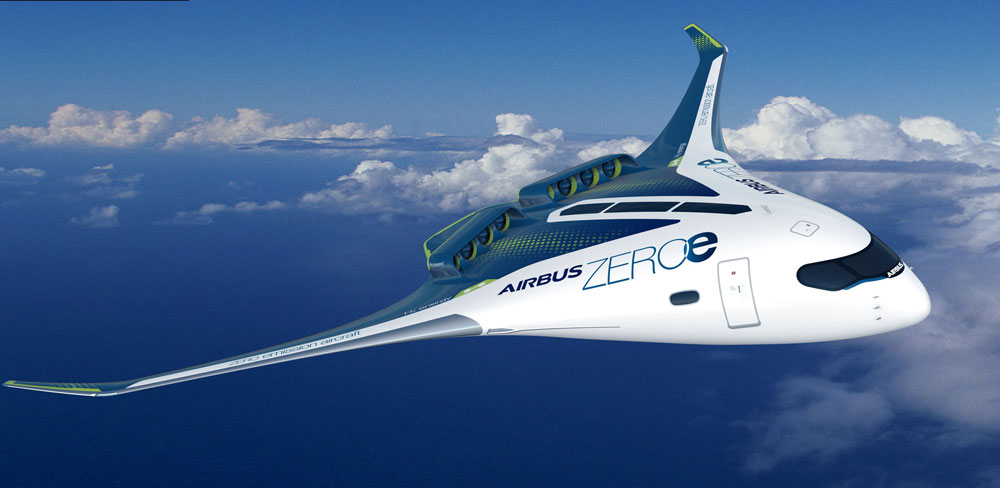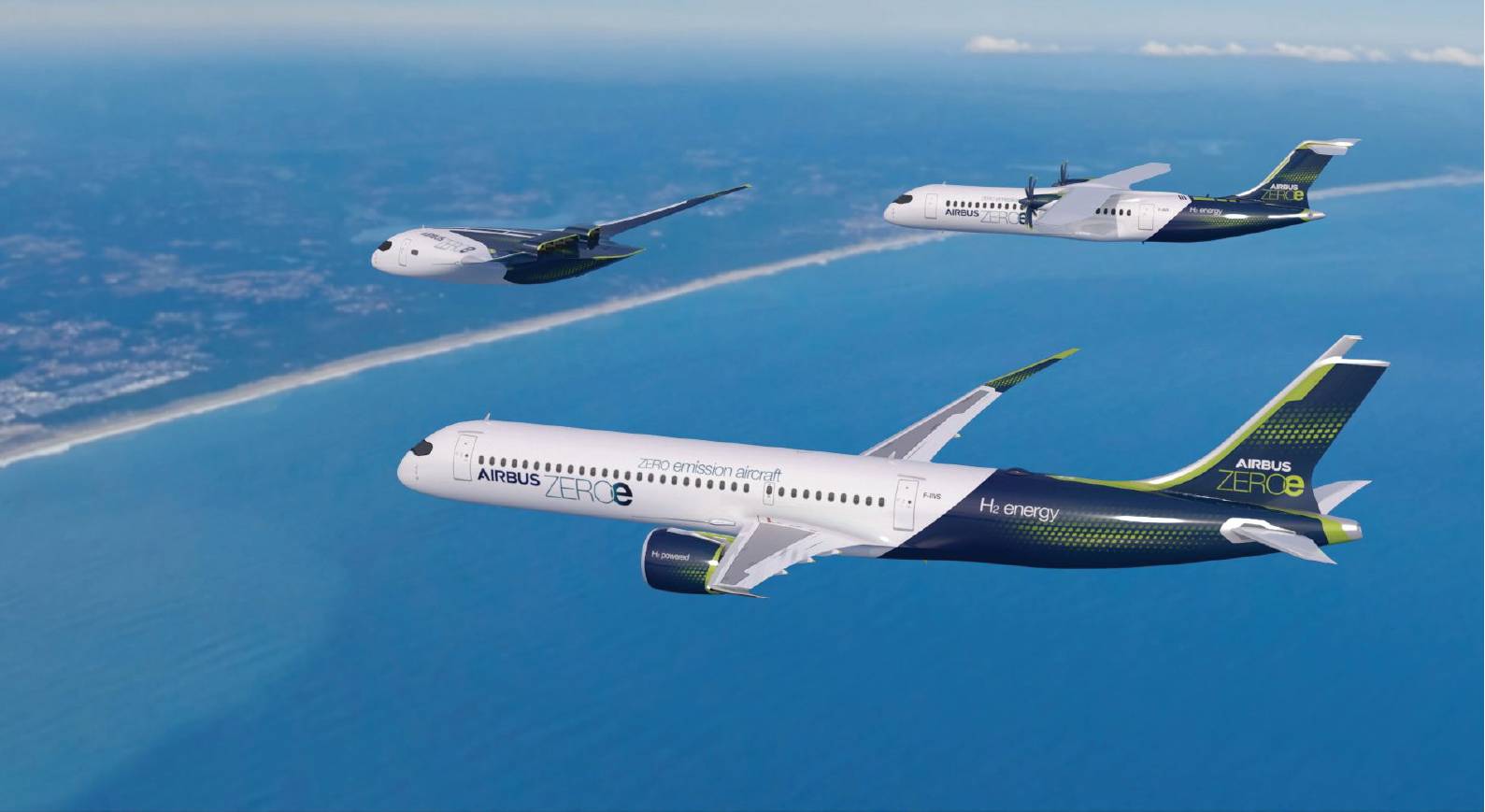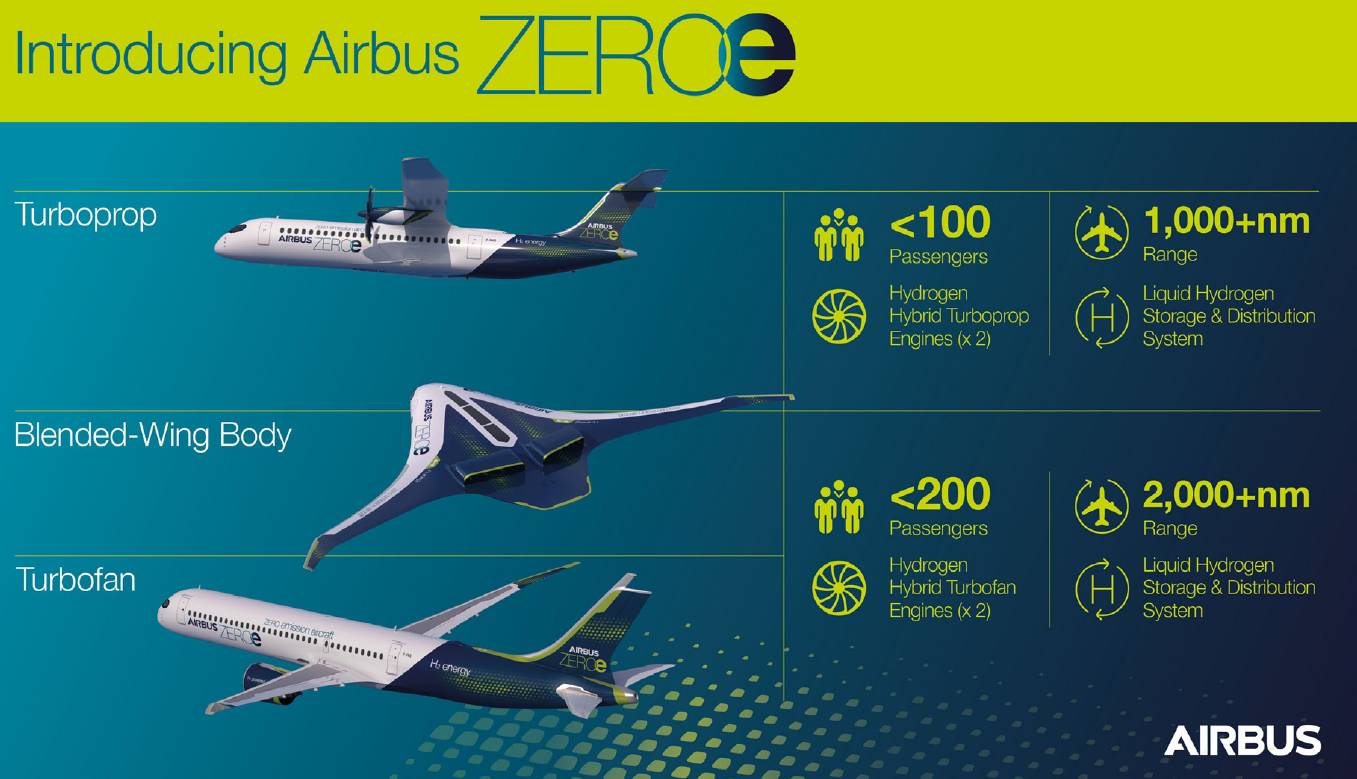AEROSPACE Hydrogen-powered aircraft
Airbus spearheads zero-carbon Moonshot
Liquid hydrogen may blast rockets off into space but, in 2035, it could be powering zero-carbon aircraft if Airbus’ ambitious plans to lead the decarbonisation of aviation come to fruition. TIM ROBINSON FRAeS reports.
 Airbus ZEROe blended wing body concept. Airbus
Airbus ZEROe blended wing body concept. Airbus
Earlier this year, proponents of green aviation were disappointed when Airbus, in conjunction with partner Rolls-Royce, axed its modified BAe 146 hybrid-electric E-FanX demonstrator before it had even flown. Yet, what seemed to be at the time a setback for progress in sustainable aviation, has now turned out to be just a small bump in the road to the launchpad of a far more ambitious aim – to develop a zero-carbon airliner by 2035.
One might think that, given the grave existential crisis that aviation currently finds itself in due to the Covid-19 crisis, the pressure from the environmental lobby would have eased and aerospace manufacturers would have breathing space to focus on just surviving. Yet, ironically, the opposite has happened. With clearer skies, less pollution and better air quality, the mass grounding of the world’s airline fleets has given people a glimpse of what a zero-carbon, cleaner future might be like.
While the world’s airlines are in deep crisis and delaying deliveries of current-generation aircraft, some argue that this is the perfect time for the aerospace industry to look even further ahead and rethink and reset itself for a zero-carbon future-ready for when demand returns and the inevitable growth in air travel comes back.
Airbus pivots to hydrogen
Indeed, this seems to have informed Airbus’ thinking when, on 21 September, it unveiled three ZEROe concepts for hydrogen-powered airliners, ranging from a regional turboprop, turbofan and a blended wing body (BWB) design – which, it says could be in service by as soon as 2035. Airbus CEO Guillaume Faury described the unveiling as: “a historic moment for the commercial aviation sector as a whole and we intend to play a leading role in the most important transition this industry has ever seen.”
ALL THESE AIRCRAFT WOULD USE HYBRID ELECTRIC ARCHITECTURES, LEVERAGING AIRBUS’ KNOWLEDGE ON E-FANX, WITH ELECTRIC MOTORS EMBEDDED IN THE GAS TURBINES AND POWERED BY FUEL CELLS
The hydrogen-powered turbofan ZEROe airliner, looking conceptually like a scaled-down A350, would seat 150-200 passengers, with a range of nearly 2,000 miles. Liquid hydrogen would be stored in the rear fuselage. Another ZEROe concept is for a hydrogen-powered turboprop, for 100 passengers and a range of up to 1,000 miles. The final concept is for a 200-seat BWB design, based on the company’s Maveric testbed revealed at the start of this year. Its range would be approximately 2,000 miles but the volume of the fuselage would open up multiple options for cabin layout and storage of hydrogen. All these aircraft would use hybrid-electric architectures, leveraging Airbus’ knowledge on E-FanX, with electric motors embedded in the gas turbines and powered by fuel cells.
It is important to note that, while these are CGI concepts, this represents a firm product development plan by the company. Airbus aims to downselect from these three in 2022-23 and officially launch the programme in 2025, ahead of a ten-year plan to bring a zero-carbon airliner into service in 2035. A flight demonstrator programme will also support this effort which Airbus aims to fly before 2025. The company hints that the BWB concept may already have an advantage, says Glenn Llewellyn, Vice President, Zero Emission Aviation, Airbus, speaking at a media roundtable: “We know from our analysis we may achieve a better performance with a more disruptive overall aircraft design. One of the challenges associated with hydrogen is that it has more volume than kerosene per unit of energy and, therefore, the blended wing body flying wing approach is fairly adapted to that”, adding: “the race is on between those different concepts.”
Being this transparent about future product development to rivals, customers and media is highly unusual, as Llewellyn stressed: “It is very unusual for Airbus to be talking about a programme ambition, a commercial aircraft entry into service 10-15 years before we plan to do it. The reason that we’re doing it is because we recognise that this programme is not only about Airbus; it’s also about driving change in the energy and aviation ecosystem,” adding: “We’re here as a call for action, to ask for help, to ask for these companies, these players to join us on this ambition to deliver a zero-emission aircraft. We will not do this on our own and that’s probably as significant as the technology challenge”.
This then, is not just an Airbus CGI of sleek future airliners but the company launching a commercial aerospace ‘moonshot’ that has the potential to touch almost every part of civil aviation as we know it.
 CGI formation flight of ZEROe concept aircraft under consideration. The turbofan concept would feature a ‘chimney’ on top of the fin to vent hydrogen in the event of any emergency. Airbus
CGI formation flight of ZEROe concept aircraft under consideration. The turbofan concept would feature a ‘chimney’ on top of the fin to vent hydrogen in the event of any emergency. Airbus
Moonshot or incremental approach?
Of course, moonshots can fall short. Concorde, for example, though an engineering masterpiece and aeronautical work of art, never broke through into mainstream success. Airbus’ previous ‘moonshot’, the A380, also offers a cautionary tale of hubris and trying to bend the market to your will. Over at Boeing, the combination of composites and a new outsourced production model almost did for the 787 Dreamliner.
A clean slate? The Covid-19 crisis has opened up the opportunity for aviation to reinvent itself as a zero-carbon form of transport.
The incremental approach then, can also offer firm advantages getting green technology into service faster. Boeing, for example, has since 2012, test-flown sustainable technology on its annual ecoDemonstrator programme – which sees an in-service airliner modified to trial advances such as drop-in-sustainable aviation fuels, recycled carpets, laminar flow aerodynamics and optimised flight routing. This year it partnered with Etihad Airways to test new technologies on a 787-10 Dreamliner. These included sustainable aviation fuel, quieter landing gear, and the biggest-ever noise research project in partnership with NASA – as well as an antiCovid-19 UV flight deck disinfectant lamp that is now being fast-tracked into production.
Over the past eight years, one-third of ecoDemonstrator sustainable technology projects have already made it into service, with another third still being researched and the last third being judged not ready yet, says Boeing’s Mike Sinnett, Vice President, Product Development. Boeing’s ecoDemonstrator then provides an approach where incremental advances can be quickly tested and adopted.
However, Sinnett was sceptical about Airbus’ ambitious plan for hydrogen-powered airliners in the next 15 years saying: “I don’t think it’s something that’s right around the corner” and noting the vast experience that the industry and operators had built up with Jet-A1-fuelled airliners over decades.
Nearer than we think
Yet hydrogen-powered aircraft are now already with us. The same week as Airbus’ announcement also saw a historic aviation milestone in UK skies with the first flight of ZeroAvia’s hydrogen fuel-cell-powered six-seat Piper M demonstrator at Cranfield, UK, on 25 September. “One of the most historic flights in decades” said the new UK Aviation Minister, Robert Courts, MP of the flight.
 ZeroAvia’s hydrogen fuel-cell-powered six-seat Piper M demonstrator. ZeroAviaThis achievement, the first flight of a ‘commercial grade’ hydrogen-powered aircraft is thus a major milestone for zero-emission flight – ZeroAvia CEO and founder Val Miftakhov saying: “It’s hard to put into words what this means to our team but also for everybody interested in zero-emission flight. While some experimental aircraft have flown using hydrogen fuel cells as a power source, the size of this commercially available aircraft shows that paying passengers could be boarding a truly zero-emission flight very soon.”
ZeroAvia’s hydrogen fuel-cell-powered six-seat Piper M demonstrator. ZeroAviaThis achievement, the first flight of a ‘commercial grade’ hydrogen-powered aircraft is thus a major milestone for zero-emission flight – ZeroAvia CEO and founder Val Miftakhov saying: “It’s hard to put into words what this means to our team but also for everybody interested in zero-emission flight. While some experimental aircraft have flown using hydrogen fuel cells as a power source, the size of this commercially available aircraft shows that paying passengers could be boarding a truly zero-emission flight very soon.”
ATI-backed ZeroAvia now plans to demonstrate longer range (200-300nm) flights with the Piper M before the end of the year, before turning its attention to offering its hydrogen powertrain to convert existing 19-seat class aircraft, such as the Dornier 228 and Cessna SkyCourier, to zero-carbon flight in the next three to four years. With ZeroAvia aiming its powerplant to be in ubiquitous PT6 turboprop-class, it could have wide applications.
Even though this six-seater is at the small end of the zero-carbon scale compared to Airbus’ plans, Miftakhov reveals that it has already attracted big commercial interest with over 30 discussions with operators, ten letters of interest (LoI) and seven talks with aircraft OEMs.
Thinking further out of the box
Finally, there may be even more radical ideas to harness hydrogen as a potential zero-carbon aviation fuel. Earlier this year, ex-Airbus and UTC Chief Technology Officer, Paul Eremenko, revealed his latest project – Universal Hydrogen, which aims to turn hydrogen into separate mini-fuel cell tanks that could be loaded onto aircraft, cargo container-style, removing the need for cryogenic refuelling at airports. Universal Hydrogen aims to have its technology ready by 2024.
Meanwhile, hybrid-airship specialists Hybrid Air Vehicles is already working on a future electric version of its Airlander airship, in partnership with Collins. CEO Tom Grundy also notes that Airlander could be perfect for pulling through new green technologies like these – as the airship already gives a 70% reduction in CO2 emissions compared to conventional aircraft. With a hydric-electric configuration this would increase to a 90% reduction and 100% with an all-electric power. Perhaps most interesting of all, the giant internal volume of airships would potentially allow for easier storage of hydrogen than conventional wings and tube airliners where, as the volume of hydrogen increases, so does the drag. HAV is now proposing that Airlander could find a new role as a point-to-point 90-seat regional aircraft – with ‘fast ferry’ style speeds as the world shifts to a zero-carbon future.
However, like hydrogen-powered airliners and electric flight, widespread adoption of airships as regional transports will need big changes and adjustments in flight operating procedures, infrastructure and customer expectations. Will passengers accept flying slower (in the case of electric/hybrid-electric aircraft and airships) but greener in the future? (See Taking charge of electric aircraft)
 Airbus ZEROe turboprop concept. Airbus
Airbus ZEROe turboprop concept. Airbus
Challenges
In order for commercial aviation to pivot to hydrogen, there still remain significant challenges – both from a technical standpoint and from logistics and scaling up this alternative fuel. Some critics also point out that, while hydrogen is ‘zero-carbon’, burning it as a fuel is not zero-emission – it does produce NOX X and water vapour. Water vapour may seem harmless but can contribute to the formation of contrails and radiative forcing which is linked with climate change and the greenhouse effect. Water vapour contrails then may have to be paired with advanced air traffic management to steer clear of contrail formation areas. Research done by the Royal Aeronautical Society’s Greener by Design Group suggests that this could be quite easily achieved with today’s space-based real-time weather surveillance and with minimal operational and economic impact on airlines. Tactical military aircraft already avoid the contrail layer, if possible to prevent giving away their position to enemies within visual range – could civil airliners do the same?
IN VERY SIMPLE TERMS, THERE’S NO OTHER WAY FOR SOCIETY TO MEET THE PARIS CLIMATE AGREEMENT COMMITMENT WITHOUT HYDROGEN
Glenn Llewellyn Vice President, Zero Emission Aviation, Airbus
There is also the issue that hydrogen may not scale well – unlike kerosene fuel. Paradoxically, the bigger the aircraft, the more weight and volume that cryogenic tanks for liquid hydrogen and its associated systems take up – undermining seatmile economics. It may be then that A320-sized aircraft with a range of 1,500-2,000nm could be the upper limit, before the cryogenic fuel tank weight and volume (and thus drag) spirals up and makes it unprofitable. Says Llewellyn: “With the technology that we are targeting for 2035, we see that sort of passenger numbers, 200, maybe a bit more, being the upper limit for the technology. We expect that subsequent generations of hydrogen-powered aircraft could potentially start moving upwards of 200 passengers but probably not for the first iteration of large commercial hydrogen aircraft.” Sustainable aviation fuels (whether biofuels or synthetic E-fuels) will thus still have a part to play.
Another factor to consider is how the hydrogen is made. A true zero-carbon supply chain would see the ‘green hydrogen’ produced by renewable energy – such as wind or solar power. However, that still remains a fraction of energy consumed. ‘Grey hydrogen’, with the fuel produced by electricity from coal, oil or gas power then might have to do for the foreseeable future but can that be called fully zero-carbon? However, there is cause for positivity here for, as Llewellyn notes, the economics of renewables are shifting fast: “What we already see in 2020 is the beginning of exponential growth in terms of those energy production methods that is driven primarily by the fact that the cost of those production methods have gone down significantly over the last few years.”
There is also the immense logistics, infrastructure and supply chain aspect of introducing a whole new fuel – as one person once described it: ‘turning Heathrow into Cape Canaveral’. Airports would need to be upgraded all around the world, with cryogenic fuel supply and storage on a scale that is difficult to fathom – especially if narrowbody aircraft, which make up the bulk of the airliners in the world‘s fleet, will be the first to be converted to hydrogen. It is worth pointing out that this will include those airports where hydrogen-powered aircraft might have to divert to as well.
Finally, there is the certification aspect. Recent events have shown in stark detail what happens when an aviation regulator is gutted of expertise and companies practise self-regulation. It is thus clear that, for a new fuel and propulsion system, and with the public’s, politicians’ and the media’s minds jumping to the Hindenburg whenever hydrogen and flight are mentioned, regulators will need to be ultracautious when approaching certification.
There are thus significant challenges – both from a technical standpoint and the logistics. However, these are not insurmountable.
 Airbus
Airbus
Summary
Make no mistake – this is a gigantic undertaking which Airbus itself admits it cannot hope to achieve by itself – commercial aviation’s equivalent of the Apollo Lunar programme. Even the introduction of the jet age in the 1950s perhaps was not as significant, as jets had been in service since WW2 and fuel was still oil-based. Hydrogen and the related electrification of aviation will thus need support and buy in across multiple stakeholders and sectors, from airlines to energy producers. It will also require understanding and education on the part of consumers, the media and politicians on the limits of certain types of technology and how zero-carbon air travel could alter traditional business models and passenger experience. For example, would communities near small airfields welcome a huge increase in movements of electric or hydrogen-powered commuter aircraft if that would facilitate cheap, zero-carbon point-to-point travel?
What is different this time around is that the push for this new greener technology is coming from society itself, rather than as a side-effect of ever more efficient engines, lighter materials and reduced drag that aviation engineers have always aimed for since the Wright brothers first flew.
There is thus a huge opportunity for the aviation industry, which has been fighting a rearguard action in trying to convince policymakers it is serious about reducing its carbon footprint, to embrace this wholeheartedly and run with it.
In the UK, zero-carbon aviation has been given a high priority, with the formation of the industry/government JetZero Council partnership to focus and help channel development in this area with the goal of zero-emission transatlantic flight in a generation. This is also a priority elsewhere in Europe – with the French government’s €15bn bailout to the aerospace and aviation sector coming with the understanding that sustainable green projects should be fast-tracked.
This then represents a huge opportunity to reset the sector that will allow people to travel again, guilt-free, and airlines to grow, while massively reducing the impact on our planet. Airbus’ Llewellyn says: “In very simple terms, there’s no other way for society to meet the Paris Climate Agreement commitment without hydrogen. Hydrogen is here with us to stay, and it’s something that will have infrastructure developed for it, will have a reducing cost curve, and we are sure that aviation needs to be positioned to take advantage of that. “In the end, if aviation is to meet the challenge of sustainable green growth, then this is a moonshot worth aiming for”.
Climate Change, RAeS Virtual Conference – 3-4 November 2020.
 Airbus ZEROe blended wing body concept. Airbus
Airbus ZEROe blended wing body concept. Airbus


